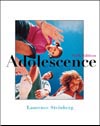| Major Section | Study Guide Features |
| | |
| I.Identity as an Adolescent Issue | Learning Objectives: 1 |
| | Important terms: self conception, self- esteem Multiple choice questions: 1, 4 Matching questions: 2, 7 |
| | |
| II.Changes in Self-Conceptions | Learning Objectives: 2 |
| | Important terms: false-self behavior Multiple choice questions: 2, 30 Fill in the blank questions: 2 |
| | |
| A.Dimensions of personality | Learning Objectives: 3 |
| in adolescence | Important terms: Five Factor Model, |
| | Big Five Multiple choice questions: 3, 34 Fill in the blank questions: 3 Matching questions: 8 |
| | |
| III.Changes in Self-Esteem | Learning Objectives: 4- |
| | Important terms: self-consciousness, self-image stability, barometric self-esteem, baseline self-esteem Multiple choice questions: 5-6 Fill in the blank questions: 4, 5, 25, 31 Matching questions: 9, 14 |
| | |
| A.Sex, class and ethnic | Learning Objectives: 5 |
| differences in self-esteem | Multiple choice questions: 7, 32 |
| | Fill in the blank questions: 6-7 |
| | |
| B.Ethnic Differences in Self-Esteem: | Learning Objectives: 5 |
| Studying Means versus | Important terms: analysis of |
| Studying Correlation's | variance, independent variable, |
| | correlation coefficient Multiple choice questions: 9,10,33 Fill in the blank questions: 8, 24 Matching questions: 3, 5, 10, 18 |
| | |
| C.Antecedents and consequences | Multiple choice questions: 8, 11 |
of high elf-esteem | |
| | |
| IV.The Adolescent Identity Crisis | Important terms: Eric Erikson, |
| | sense of identity, Matching questions: 1 |
| | |
| A.Erikson's theoretical framework | Learning Objectives: 6 |
| | Important terms: psychosocial crisis Multiple choice questions: 12-13 |
| | |
| B.Identity versus identity diffusion | Important terms: identity versus |
| | identity diffusion Fill in the blank questions: 9 |
| | |
| C.The social context of identity | Important terms: psychosocial |
| | developmentmaturation Fill in the blank questions: 10 Matching questions: 6 |
| | |
D.Resolving the identity crisis | |
| | |
| E.Problems in identity development | Learning Objectives: 7 |
| | Important terms: identity diffusion, identity foreclosure, negative identity Multiple choice questions: 14-18 Fill in the blank questions: 12-13 Matching questions: 13, 15, 19 |
| F. Are There Sex Differences In | |
The Route To A Sense of Identity | |
| | |
| V. Research on Identity Development | |
| | |
| A.Determining an adolescent's | Learning Objectives: 8 |
| identity status | Important terms: James Marcia |
| | Multiple choice questions: 19, 20, 28, 29 Fill in the blank questions: 14, 15-17 Matching questions: 16 |
| | |
| B.Studying identity development over time | Multiple choice questions: 21 |
| | Fill in the blank questions: 18 |
| | |
C.Shifts in identity status | |
| | |
VI.The Development of Ethnic Identity | |
| | |
| A.The process of ethnic identity | Learning Objectives: 9 |
| | developmentImportant terms: ethnic identity, racial socialization Multiple choice questions: 23 Fill in the blank questions: 19 Matching questions: 12 |
| | |
| B.Alternative orientations to ethnic identity | Learning Objectives: 9 |
| | Important terms: biculturalism, code switching Multiple choice questions: 22, 24 Fill in the blank questions: 20-21 Matching questions: 12 |
| | |
| VII.Gender Role Development | Learning Objectives: 10 |
| | Important terms: androgeny Fill in the blank questions: 22 Matching questions: 11 |
| | |
| A.Gender-role socialization in | Learning Objectives: 10 |
| adolescence | Important terms: gender |
| | intensification hypothesis Multiple choice questions: 25, 27 Fill in the blank questions: 23 |
| | |
| B.Masculinity, femininity and androgeny | Learning Objectives: 10 |
| | Multiple choice questions: 26 Fill in the blank questions: 23 |



 2002 McGraw-Hill Higher Education
2002 McGraw-Hill Higher Education